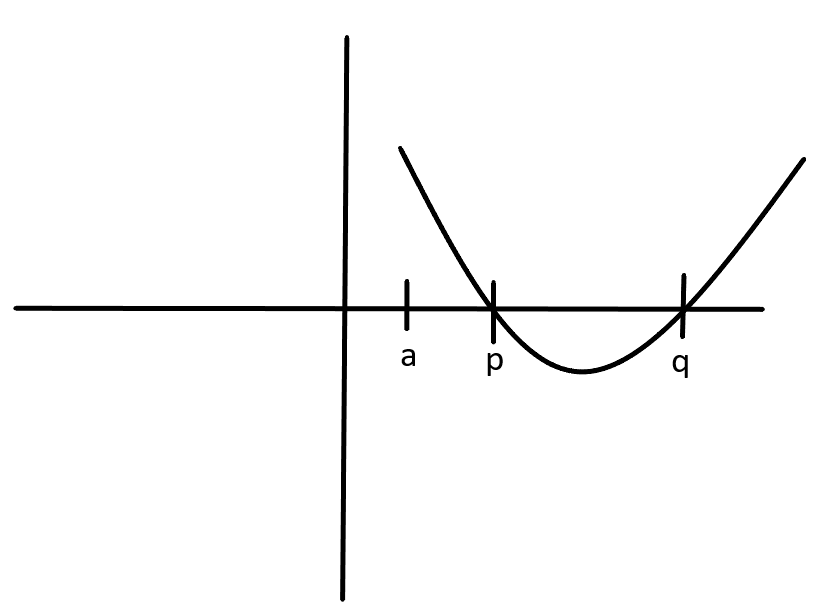
If the roots of ${x^2} + x + a = 0$ exceed $a$, then
A. $2 < a < 3$
B. $a > 3$
C. $ - 3 < a < 3$
D. $a < - 2$
Answer
133.2k+ views
Hint: Check the concavity of the given quadratic equation and using this information check whether $f(a)$ is positive or negative. Also use the fact that the discriminant must be greater than 0 as real roots exist. With the two inequalities, find the range of a.
Formula used: Discriminant of the standard quadratic equation $a{x^2} + bx + c = 0$ is ${b^2} - 4ac$
Complete step-by-step solution:
Let $f(x) = {x^2} + x + a$
The coefficient of ${x^2}$ in the equation ${x^2} + x + a = 0$ is greater than 0. Therefore, it is a concave upwards graph. Since it is a concave upwards graph, $f(x)$ will be negative only when $x \in \left[ {p,q} \right]$ where $p,q$ are the roots.

Therefore, $f(a)$ is positive. We also know that real roots exist. Therefore, the discriminant of the quadratic equation, ${x^2} + x + a = 0$ must also be greater than 0.
Since $f(a) > 0$,
${a^2} + a + a > 0$
${a^2} + 2a > 0$
$a(a + 2) > 0$
$a \in \left( { - \infty , - 2} \right) \cup \left( {0,\infty } \right)$
Since discriminant, $D > 0$,
$1 - 4a > 0$
$4a < 1$
$a < \dfrac{1}{4}$
$a \in \left( { - \infty ,\dfrac{1}{4}} \right)$
Taking the intersection of $\left( { - \infty , - 2} \right) \cup \left( {0,\infty } \right)$ and \[\left( { - \infty ,\dfrac{1}{4}} \right)\] we get $a \in \left( { - \infty , - 2} \right)$.
Therefore, the correct answer is option D. $a < - 2$.
Note: Given a quadratic polynomial $a{x^2} + bx + c$, if $a > 0$ then the graph of the quadratic polynomial will be a concave upwards graph and if $a < 0$ then the graph of the quadratic polynomial will be a concave downwards graph.
Formula used: Discriminant of the standard quadratic equation $a{x^2} + bx + c = 0$ is ${b^2} - 4ac$
Complete step-by-step solution:
Let $f(x) = {x^2} + x + a$
The coefficient of ${x^2}$ in the equation ${x^2} + x + a = 0$ is greater than 0. Therefore, it is a concave upwards graph. Since it is a concave upwards graph, $f(x)$ will be negative only when $x \in \left[ {p,q} \right]$ where $p,q$ are the roots.

Therefore, $f(a)$ is positive. We also know that real roots exist. Therefore, the discriminant of the quadratic equation, ${x^2} + x + a = 0$ must also be greater than 0.
Since $f(a) > 0$,
${a^2} + a + a > 0$
${a^2} + 2a > 0$
$a(a + 2) > 0$
$a \in \left( { - \infty , - 2} \right) \cup \left( {0,\infty } \right)$
Since discriminant, $D > 0$,
$1 - 4a > 0$
$4a < 1$
$a < \dfrac{1}{4}$
$a \in \left( { - \infty ,\dfrac{1}{4}} \right)$
Taking the intersection of $\left( { - \infty , - 2} \right) \cup \left( {0,\infty } \right)$ and \[\left( { - \infty ,\dfrac{1}{4}} \right)\] we get $a \in \left( { - \infty , - 2} \right)$.
Therefore, the correct answer is option D. $a < - 2$.
Note: Given a quadratic polynomial $a{x^2} + bx + c$, if $a > 0$ then the graph of the quadratic polynomial will be a concave upwards graph and if $a < 0$ then the graph of the quadratic polynomial will be a concave downwards graph.
Recently Updated Pages
Difference Between Mutually Exclusive and Independent Events

Difference Between Area and Volume

If 81 is the discriminant of 2x2 + 5x k 0 then the class 10 maths JEE_Main

The probability of guessing the correct answer to a class 10 maths JEE_Main

A man on tour travels first 160 km at 64 kmhr and -class-10-maths-JEE_Main

In a family each daughter has the same number of brothers class 10 maths JEE_Main

Trending doubts
JEE Main 2025 Session 2: Application Form (Out), Exam Dates (Released), Eligibility & More

JEE Main Syllabus 2025 (Updated)

JEE Mains 2025 Cutoff: Expected and Category-Wise Qualifying Marks for NITs, IIITs, and GFTIs

JEE Main Marks Vs Percentile Vs Rank 2025: Calculate Percentile Using Marks

Molar Conductivity

How Many Students Will Appear in JEE Main 2025?

Other Pages
Maths Question Paper for CBSE Class 10 - 2007

NCERT Solutions for Class 10 Maths Chapter 11 Areas Related To Circles

NCERT Solutions for Class 10 Maths Chapter 12 Surface Area and Volume

NCERT Solutions for Class 10 Maths Chapter 13 Statistics

NCERT Solutions for Class 10 Maths In Hindi Chapter 15 Probability

Areas Related to Circles Class 10 Notes CBSE Maths Chapter 11 (Free PDF Download)




